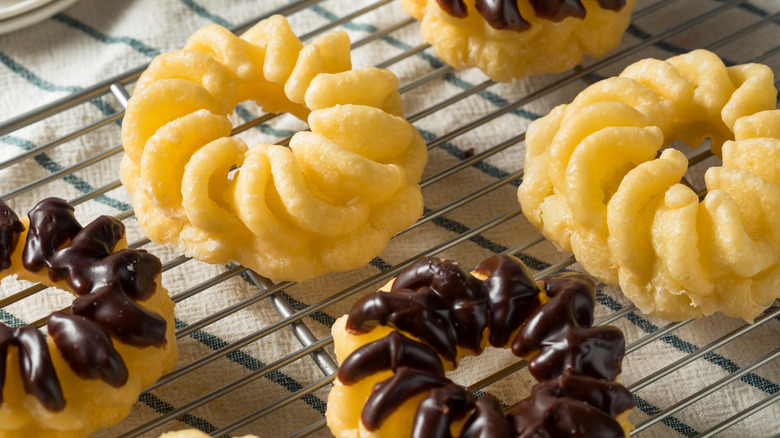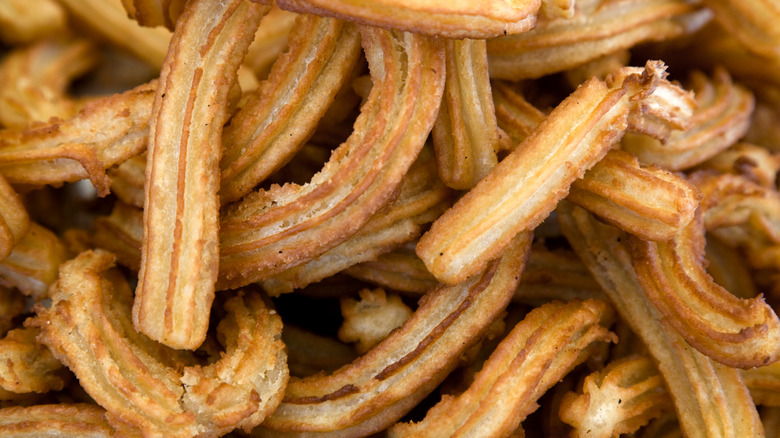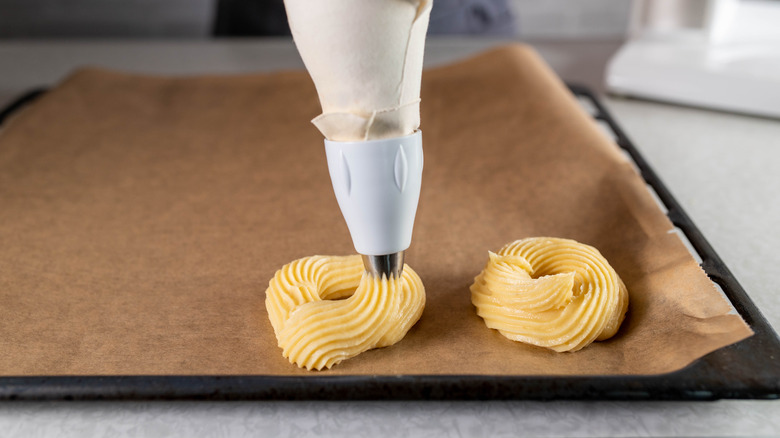What Are Cruller Donuts (And Where Do They Come From)?
Crullers are delicious treats, typically designated as donuts, although one of the most popular kinds of crullers is made from choux pastry dough. The French cruller is a ring-shaped creation that's fried and usually glazed, crispy on the outside, and super moist, light, and airy on the inside. These differ from a yeasted doughnut or a cake doughnut because of the texture achieved from frying the choux dough. Choux is an important technique in French pastry (think cream puff pastry, eclairs, or profiteroles). The dough incorporates beaten eggs, which not only account for the rise and pockets of air inside but also a particular eggy flavor. Once made, the dough is piped into hot oil, giving it the iconic ridges that work so well for catching glaze.
And yet, while these delicacies are tagged as French, they have German and Dutch origins. The word "cruller" is possibly a derivative of the word "krullen" in Dutch, which translates to "curl." That seems appropriate given that these are usually circular, like their categorical brethren (although it is possible to find them in bar form, both formats are twisted). Crullers are undoubtedly part of the long and mouthwatering history of donuts, but have a story all their own.
Multicultural origins of crullers
While the word cruller can point us in the direction of the Dutch, who probably had a major hand in transporting this treat to Pennsylvania in the late 18th century, evidence points to German and Polish origins as well. The German version is known as spritzkuchen and hails from a Berlin-adjacent region near Poland, where it is a classic treat for Karneval celebrations or at Christmas markets. A Polish variety, called chrusciki, bears little resemblance to what we know as a donut and instead looks like bow ties (or angel wings). These are made with sour cream, and lemon zest, and dusted with powdered sugar.
The fried dough cruller exists beyond Eastern Europe and North America. An Asian and Southeast Asian treat called youtiao (also known as a "Chinese cruller") shares the crisp outside and airy interior of the French style. And anyone who has enjoyed Mexican or Spanish churros can see the kinship with a cruller. Both are made with an egg-enriched batter and fried — although churros are usually dusted with cinnamon and sugar, rather than glazed.
Migration and the modern cruller
Today, crullers have found a place in cultures all over. Milwaukee counts them as part of the region's culinary identity (where they sometimes pronounce it as "crawlers"), thanks to German immigrants arriving in the area in the 19th century. This type of cruller is closer to the original German and Dutch style, shaped like a bar and in some cases made with buttermilk.
So beloved is the commercially made Dunkin' French cruller that its limited availability has prompted an outcry among loyal customers who have had trouble finding them over the years (apparently the company's selection varies regionally, which may be part of its mystery). Small and independent donut shops and bakeries today play with their takes on the classic. New York's Daily Provisions offers a rotating monthly cruller selection (with flavors like yuzu basil), along with their standard cinnamon and maple glazed, and even filled versions with jams or creams. Regardless of where you find them today, a perfectly fried cruller is a delicious donut variation with a delightful history.


